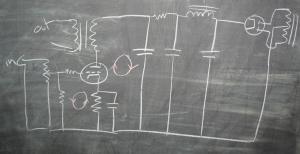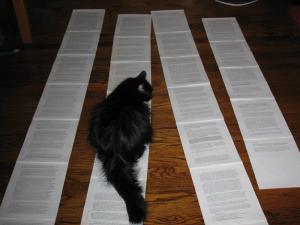-
Posts
4,877 -
Joined
-
Days Won
76
Content Type
Profiles
Forums
Events
Everything posted by dsavitsk
-

the NEW Zana Deux, ZDT and Balancing Act thread
dsavitsk replied to oatmeal769's topic in Headphone Amplification
It's a big topic. These are probably as good as anywhere to get started: [url=http://www.sixmoons.com/industryfeatures/distortion/distortion.html]6moons.com - industry features: "Distortion & -

the NEW Zana Deux, ZDT and Balancing Act thread
dsavitsk replied to oatmeal769's topic in Headphone Amplification
Lots of things have turned the amp world on its head. Feedback, transistors, Class B, Class D, etc. Maybe OTL is among them. That doesn't mean that these things lasted, or that the long term evaluation is necessarilly good. It also doesn't mean that they are bad. I am sure there are plenty of wonderful OTL amps out there (well, I'm not actually sure of that, but for the sake of argument I'll stipulate to it), but OTL is too generic of a description to necessarilly mean much. There are certainly bad ones too. Me, I often use transformers as I find the designs I make with them to be both intellectually interesting, and good sounding. But, you'll find that others disagree. -

the NEW Zana Deux, ZDT and Balancing Act thread
dsavitsk replied to oatmeal769's topic in Headphone Amplification
The primary reason for good tube sound is that tubes are very linear devices. Transformers are useful things, and when correctly designed and implemented, will do little damage to the signal. Transformers get a bad rap because good ones tend to be expensive. You have your decades wrong. The poor designs are from the 50's. Transformers were, by then, old hat. Oh my. -

DNA (Donald North Audio) Headphone Amp
dsavitsk replied to blubliss's topic in Headphone Amplification
You mean to say that there are people selling snake oil to audiophiles? By the way, don't take my comment that the Jensen electrolytic cap fits to be an endorsement of Jensen electrolytic caps. I've never used one and consequently I have no opinion of them. My preference would be a large film cap of some sort, but those likely won't fit in the existing hole. Most tube power amps, at least those built with a modicum of safety in mind, have the speaker returns connected to ground. -

DNA (Donald North Audio) Headphone Amp
dsavitsk replied to blubliss's topic in Headphone Amplification
There is the "signal" path, and then there is the signal path. The big JJ and the cathode bypasses are both in the signal path and will have a large influence on sound. You can buy that cap at Parts Connexion on sale for $50 right now, and the soldering will take you about 10 minutes. It looks like it is even the same diameter so it should fit the chassis nicely. -

DNA (Donald North Audio) Headphone Amp
dsavitsk replied to blubliss's topic in Headphone Amplification
Tubes are, it turns out, extremely linear devices. The warmth and poor frequency response often attributed to them has more to do with topology and other components than the tubes themselves. -

DNA (Donald North Audio) Headphone Amp
dsavitsk replied to blubliss's topic in Headphone Amplification
Doesn't that suggest that it is capacitor warmth? -
I don't think it adheres to any standards. They basically drew it with a sharpie and used jumpers and bits of wire to connect things -- you should see under the board. Yeah -- I think it is a 2mA jump.
-
Thanks. It's a tough call as to how much work to do on one of these. Certainly, one could use all V-Caps and Blackgate NXes, build some super duper fancy regulator, rework the solid state power supply, etc. But, the circuit has inherent limitations, and I tried to stay within them and not let this get out of hand. Though, those 2u caps may get replaced with something a little better.
-
Not true. Here's my DAC. You can thump on those tubes all day long with nary a peep.
-
I have been thinking about parting with my Melos SHA-1 for a while. It was [url=http://www.stereophile.com/headphones/617/]Corey Greenberg
-
from the datasheet:
-
It would be great if they would sell just the board to non Ayre/Wavelength owners. That, even I would buy. Maybe when one of you guys upgrade, I'll buy the old board off of you ... seriously.
-
These (ESW9's) ended up getting sold off. The sound never really grew on me so they weren't getting used. And, more importantly, they physically hurt my ears after about an hour. Oddly, I can wear my Grados all day (and often do) and they are totally comfortable. Back to the drawing board ...
-
[ame=http://en.wikipedia.org/wiki/Penis_Landscape]Penis Landscape - Wikipedia, the free encyclopedia[/ame]
-
-

DNA (Donald North Audio) Headphone Amp
dsavitsk replied to blubliss's topic in Headphone Amplification
That's the trick, of course and why I say that Donald's amp is a welcome addition to the market even if it isn't how I would do it. I have no idea who sells an amp like I would do it. I think you have to make it yourself. -

DNA (Donald North Audio) Headphone Amp
dsavitsk replied to blubliss's topic in Headphone Amplification
I am always happy to discuss amplifier design in general, but I think the tone here was a little nastier than intended. As I say, Donald and I agree on a lot. I don't even bother to comment on the stuff I don't like at all -

DNA (Donald North Audio) Headphone Amp
dsavitsk replied to blubliss's topic in Headphone Amplification
By the way, while I will say that I disagree with just about every assertion that Donald makes in his post above (regarding bias; caps; OPT specs, manufacturers, and core material; damping; whether OPT design is a black art; optimal tube load; etc.), my interest is not in derailing Donald's sales. As noted, I do things very differently. However, this doesn't mean I think what he does is wrong, and we still probably agree more than we disagree. I like transformer coupled amps, and I am glad to see that they are becoming available. Even with my complaints, it is still topologically a step up from the SP and RSA amps of the world (and it's easy enough to mod ). So, I said my peace, and I will keep further discussions of this issue offline. -

DNA (Donald North Audio) Headphone Amp
dsavitsk replied to blubliss's topic in Headphone Amplification
I don't believe in complexity, other than where it is necessary. So, no, these changes would not greatly increase complexity. In fact, one of them would reduce cost by a couple of dollars. To be sure we are on the same page, my guess as to the schematic is attached. Donald can chime in if I am wrong about something (oh, and there should be a resistor in series with the output I believe -- he said that a few posts back.) The two circles represent the simplified signal current path. The primary sin here is that the input and output signals both pass through electrolytic capacitors. My experience is that the soft "tubey" sound of many tube amps is, in large part, actually the sound of the capacitors which impart their sound on the amp more than any other part. At the very least these should be film caps. But, even better is finding other solutions to the issue. A first solution is to use some other method of bias. This can be an LED, a battery, or any number of options (see bias options here). Which ever the choice, almost all of them are better than the old resistor + cap. The second issue is the power supply. Aside from the big cap in the signal path, this is a high Z supply that will sag with signal. Sag is great in a guitar amp, but not so great for hifi. A simple linear regulator will both quiet the supply and eliminate the sag. This sort of supply can literally be as simple as a single chip and a few resistors. The linear regulator still has a big cap on the output, but there are ways around that, too. Indeed, one solution is a shunt regulator. Using a CCS load for it, you can have a low Z low noise supply, and this can eliminate the cap from the signal path as well as the CCS presents a high Z barrier. I did something like that here with a glow tube. Note that mine also obtains fixed bias with a resistor by running all the current, but none of the signal, though the biasing resistor. The third issue is that I just don't think Edcor OPTs are all that great. I think they are fine for bread boards, but for a production amp, I'd expect something better. Something better costs more, and maybe that is the issue here, but if this is a budget amp then market it as such, not as an amp "with unprecedented fidelity and emotional involvement". Finally, for low Z headphones, better bass is obtained with a better damping factor. The earlier stated parameters for this amp either require that the load on the tube is too low, or that the Z out is too high. -
Just as an opposite data point, our vet said essentially the opposite, that she has seen issues with years of pills but that the radiation is pretty benign. I have no idea what the right answer is, of course. But, as I say, our kitty takes her pills so well that it is not an issue yet. For those that don't, a slight chance of kidney issues down the road seems like a reasonable risk. Here she is proofreading something for me.
-
Another option is Radiocat - Centers For The Treatment Of Feline Hyperthyroidism I have a hyperthyroid cat who takes her pills just fine, but this is supposed to work really well. It isn't free, of course, but considering the alternative it isn't really that expensive either.
-
The kitty above is Bolivia. She's about 9 and came to us about a year ago from the Tree House Humane Society which is a cageless no-kill cat shelter in Chicago. She had been rescued from a hoarder in southern Illinois about 2 years ago. If you like cats and are in Chicago and are interested in seeing a 3 story house with 300 cats roaming around, go to the Tree House. It's an experience. Below is Mani. We lost him about a year and a half ago from large cell lymphoma. He topped out at about 20 pounds and could stretch to nearly 4 feet long. He loved us, but did not like anyone else -- he would lay with his belly up just waiting to bite anyone who thought it might be soft and pet-able. His vet needed two people with leather gloves to hold him down.
-
However, it is clear that both builders did terrible jobs ... My sense, there isn't enough polish on this earth to shine up this turd. And I don't buy for a second that there is something special to the SP sound. It is poorly designed, poorly built, and inherently dangerous. I think you gut the amp, come up with a circuit that utilizes the case as best as possible, and build (or hire someone to build) something new. Short of that, if the amp portion is OK, at least build an all new PS.




